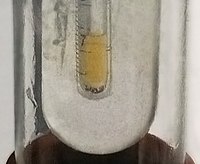
Photo from wikipedia
Perfluorinated sulfonic acids (such as perfluorooctanesulfonic, PFOS, and short-chain analogues) are notorious halogenated pollutants that exhibit severe toxicity, even at minute levels. Limited number of experimental studies addressed their thermal… Click to show full abstract
Perfluorinated sulfonic acids (such as perfluorooctanesulfonic, PFOS, and short-chain analogues) are notorious halogenated pollutants that exhibit severe toxicity, even at minute levels. Limited number of experimental studies addressed their thermal decomposition at elevated temperatures. Such scenarios are particularly relevant to open fires and incineration of materials laden with perfluoroalkyl compounds (PFCs). Herein, we construct a detail kinetic model that illustrates major chemical reactions underpinning initial degradation of 1-butanesulfonic acid (CF3(CF2)3SO2OH), as a model compound of PFOS, and perfluorinated sulfonic acids in general. Reaction rate parameters were estimated based on an accurate density functional theory (DFT) formalism. The kinetic model incorporates four sets of reactions, namely, unimolecular decomposition channels, hydrofluorination, hydrolysis, and fragmentation of the alkyl chain. Results are discussed considering recent experimental measurements. Temperature-dependent profiles for a large array of perfluoroalkyl acyl fluorides, short perfluorinated cuts, and perfluorinated cyclic compounds, are presented. SO2 emerges as the main sulfur carrier, with a minor contribution from SO3. HF addition to double carbon bonds in alkenes, and to carbonyl bonds in aldehydic structures signifies a major sink pathway for hydrogen fluoride. Addition of moisture was shown to expedite the destruction of relatively large perfluoroalkyl acyl fluorides into C1 species. Construction of this model could aid in a better understanding of the fate and chemical transformation of PFCs under a pyrolytic environment pertinent to waste incineration and fluorine mineralization.
Journal Title: Chemosphere
Year Published: 2021
Link to full text (if available)
Share on Social Media: Sign Up to like & get
recommendations!